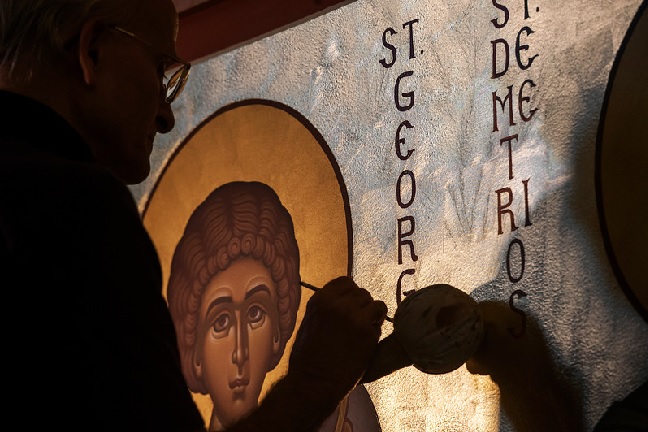|
York, PA, July 8, 2015
If
you've ever been in an Orthodox church,
you've undoubtedly been greeted with
walls covered with icons. They may look like
simple drawings, but each one has a purpose
and a specialized artist, an iconographer,
behind them.
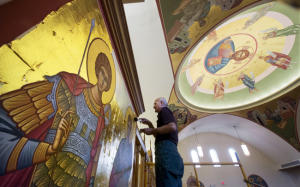 Elias Katsaros applies a thin coat of gold Saturday to a sticky adhesive on an icon in the dome he began many years before at St. John Chrysostom Antiochian Orthodox Church in Springettsbury Township. Saints George and Demetrius, the icons he is working on, were Roman warriors who died for their Christian beliefs.
Elias Katsaros applies a thin coat of gold Saturday to a sticky adhesive on an icon in the dome he began many years before at St. John Chrysostom Antiochian Orthodox Church in Springettsbury Township. Saints George and Demetrius, the icons he is working on, were Roman warriors who died for their Christian beliefs.
Here
are five things to know about the icons
you see in Orthodox churches:
How icons are made
Iconographer Elias Katsaros doesn't
actually paint the icons directly onto the
wall. It's more like wallpaper, the
Rev. Peter Pier of St. John Chrysostom
Antiochian Orthodox Church said. The
iconographer paints the icons on canvas,
then brings them to the church and cuts
them out using scissors. You need some
great scissor skills to be able to cut out
an icon, and Katsaros said he only uses a
good pair a couple times before he buys
new to ensure they're sharp.
The canvas is then glued onto the wall and
gold leaf is applied after. If the wall
leaks, the paint probably wouldn't be
ruined, the canvas would just pull away
from the wall, Pier said. That's part
of the reason Katsaros paints on canvas.
Spirit over form
The icons aren't meant to look
realistic or show detailed muscle and form
like some religious paintings.
"They're not supposed to be
beautiful, they're supposed to be
spiritual," Katsaros said.
When you come into church, you don't
want to be distracted and see big muscles,
he said. He transforms the image to be
stylized with no shadows or depth to draw
focus to the story rather than the form.
Color counts
Colors are important and symbolic in
icons. Russian Orthodox for example use
bright colors, but Greek Orthodox and
Antiochian Orthodox use earth tones that
are similar to those used in icons painted
thousands of years ago. To stick to
surfaces, paint used to be made with egg
and things from the earth, giving a muted
and faded color. Now, the tones are
similar but acrylic is used.
Red is an earth color, blue a heavenly
color. Both colors are used in the
garments of Mary and Jesus at the front of
the nave (where the congregation sits) on
the Iconostasis. Mary's dress is blue,
a heavenly color, because she held Jesus
in her womb. Her head covering is the
earth color, red, because of her humanity.
Jesus' colors are inverted, his outer
garment is blue and his inner is red,
symbolizing his heavenly presence on
Earth.
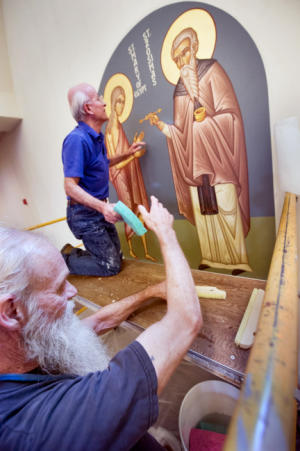 Gary Stump, bottom, of Springettsbury Township and a member of the church, keeps fresh sponges at the ready as the canvas is attached to the wall last week. Now retired, Stump helped with earlier iconography installations at the church and is now able to devote much more of time for this installation. Retired from Verizon, where climbing utility poles was part of the job, Stump said he wasn't afraid of heights. Elias Katsaros, top, began painting iconography at St. John Chrysostom Antiochian Orthodox Church in Springettsbury Township in 1996.
Gary Stump, bottom, of Springettsbury Township and a member of the church, keeps fresh sponges at the ready as the canvas is attached to the wall last week. Now retired, Stump helped with earlier iconography installations at the church and is now able to devote much more of time for this installation. Retired from Verizon, where climbing utility poles was part of the job, Stump said he wasn't afraid of heights. Elias Katsaros, top, began painting iconography at St. John Chrysostom Antiochian Orthodox Church in Springettsbury Township in 1996.
Voluntary
icons
There are some icons that are always in an
Orthodox church, always in the same
places. For example, Mary is always on the
left of the Iconostasis and next to her is
the patron saint of the church. Christ is
always in the dome and the Virgin Mary is
always in the front on the East wall.
Then, around Christ in the dome, there
will always either be prophets or
archangels telling the story of the coming
of Christ.
Aside from those mandatory icons, each
church can choose the other icons they
want displayed as well as how many they
want. St. John Chrysostom Antiochian
Orthodox Church in York chose St. Thecla
as one of their icons because she is a
woman saint. Pier says there are far too
few women saints in churches and honored
in the Antiochian denomination.
They also chose St. Nicholas (Santa Claus)
because he is one of the most popular
saints in the Orthodox church, two
hymnographers to be displayed where the
choir stands, St. Peter and St. Paul
because they are traditional and are the
most important apostles and St. Mary of
Egypt, one of the most beloved in the
church.
Taking it all in
Some people think icons are idols, but
they're not, Katsaros said.
Iconography didn't start as
iconography, there's always been art
in places of worship. Orthodox people
believe it's a representation, not
idolatry.
We take for granted that people are going
to be able to read, said Pier. But there
are people in countries where literacy is
not very common. Icons powerfully tell
stories using the visual images that
affect those who can read and those who
can't. Religion used to be an oral
tradition with no printed Bible, so
iconography is telling Bible stories
without words, the way it's been done
for over 2,000 years.
How to become an
iconographer
St. John Chrysostom Antiochian Orthodox
Church in Springettsbury Township has been
adding icons to their walls for years. The
iconographer, Elias Katsaros who lives in
Huntsville, Alabama, comes back every year
for a couple weeks to install the next
portion of icons. He put up a handful of
icons this week and expects to finish the
project next year. It's his last big
church project before he retires and
he's enjoying the work. The big church
projects are physically difficult with
climbing scaffolding and travelling
hundreds of miles to the churches and
he's tired of those aspects of the
work. Katsaros is 70 years old and started
painting icons around 1972. He has done
about 25 or 30 churches, including the
Greek Orthodox Church in York.
"Some people can do icons but
can't climb," Katsaros said. To
do big projects, you must do both.
There are only about 10 or 12
iconographers in the country, many coming
from Greece. While he is retiring, he has
had a nun under the Romanian archdiocese
studying under him for about 20 years.
While he is retiring, he'll still be
pursuing his passion of painting portraits
and sceneries and taking smaller icon
projects. His schooling is in art, which
he recommends for anyone wanting to become
an iconographer. Study anatomy too,
because if you don't know 3D
you'll mess up 2D, Katsaros said. You
have to know how to draw proportions.
There are also certain books you have to
read to do the traditional iconography,
and with the tradition's complex
history and influences, it's hard to
learn the true form. One of the books is
only written in Greek.
In Eastern countries a lot of people do
iconography because of the large Orthodox
population, Katsaros said, but he sees the
religion, especially Antiochian Orthodox,
"growing like aunts" in the U.S.
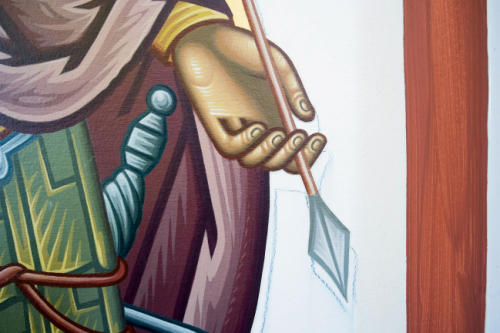 The outlines on the wall can be seen on the canvas before the border is painted. Elias Katsaros began painting iconography at St. John Chrysostom Antiochian Orthodox Church in Springettsbury Township in 1996.
The outlines on the wall can be seen on the canvas before the border is painted. Elias Katsaros began painting iconography at St. John Chrysostom Antiochian Orthodox Church in Springettsbury Township in 1996.
|
 Exhibit, "Serbia, the Land of Frescos" opened in European Parliament building, Brussels
Exhibit, "Serbia, the Land of Frescos" opened in European Parliament building, Brussels
 Exhibit, "Serbia, the Land of Frescos" opened in European Parliament building, Brussels
The exhibit "Serbia, the Land of Frescos" has opened in the European Parliament building in Brussels, reports the website of the Serbian government.
Exhibit, "Serbia, the Land of Frescos" opened in European Parliament building, Brussels
The exhibit "Serbia, the Land of Frescos" has opened in the European Parliament building in Brussels, reports the website of the Serbian government.
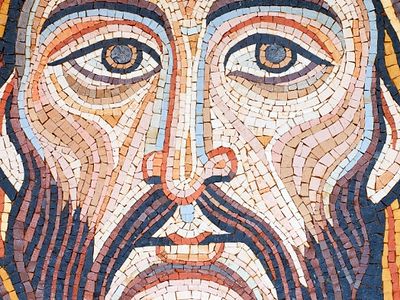 An Orthodox Response to John Calvin on Icons: Icons and Idolatry
Gabe Martini
An Orthodox Response to John Calvin on Icons: Icons and Idolatry
Gabe Martini
 An Orthodox Response to John Calvin on Icons: Icons and Idolatry
Are all religious depictions idolatry? This is a question that plagued the Roman Empire near the end of the eighth century, and again in the ninth.
An Orthodox Response to John Calvin on Icons: Icons and Idolatry
Are all religious depictions idolatry? This is a question that plagued the Roman Empire near the end of the eighth century, and again in the ninth.
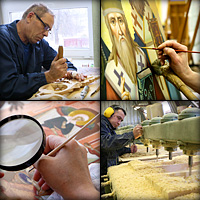 How Iconostases are Made
The story in pictures of a workshop in the ancient artisan city of Palekh
How Iconostases are Made
The story in pictures of a workshop in the ancient artisan city of Palekh
 How Iconostases are Made
The story in pictures of a workshop in the ancient artisan city of Palekh
With the help of art photographer Vladimir Eshtokin let’s visit one Palekh workshop.
How Iconostases are Made
The story in pictures of a workshop in the ancient artisan city of Palekh
With the help of art photographer Vladimir Eshtokin let’s visit one Palekh workshop.

